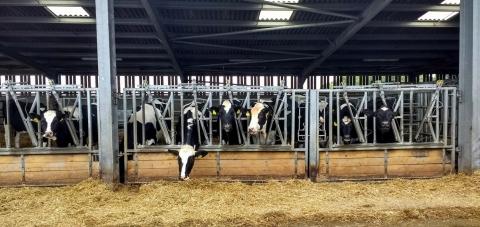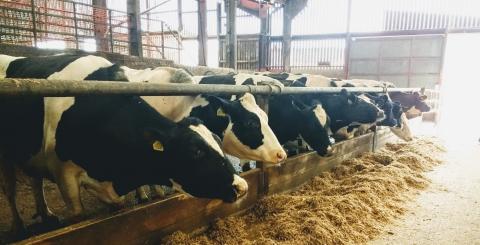14 November 2019
Dr Cate Williams: IBERS, Aberystwyth University.
- As the productivity of dairy cows has increased, so have their nutritional requirements.
- The transition period is a particularly demanding time in a cow’s life, managed improperly she will be prone to disease and disorders, significantly hampering productivity and farm profitability.
- Optimising nutrition is the key to reducing risk of production disorders such as ketosis, milk fever and acidosis.
- Feeding according to the BCS and stage in transition with a balanced diet that includes energy rich concentrates and high-quality forage will help keep cows healthy and maintain good performance throughout lactation.
Over the past century, the humble dairy cow has been transformed into a high-yielding, highly productive and highly efficient animal, designed to meet the needs of humans. Dairy cows provide large quantities of nutritionally valuable milk and dairy bulls (sired by beef breeds) provide up to 50% of all beef in the UK. However, it is important to remember that a highly productive animal also requires optimal nutrition in order to meet our expectations. Well-timed, balanced nutrition is essential for all livestock, but especially high-yielding animals, which often require more than moderately producing animals. Add to this situation the issues of budgeting, sustainability and reducing carbon footprints, and things begin to get tricky. As we have bred for ever more efficient and productive cows, scientific research has followed suit, exploring the best ways to manage the animal and shaping best practice guidelines.
A whistle-stop tour of bovine nutrition
Early research into the maintenance energy requirements of dairy heifers was based upon beef animals, but this was found to be inaccurate, as growing dairy heifers need less energy (approx. 90%) than beef cattle. The introduction of mixed diets improved first- and second- lactations and growth rates, especially over winter. As analytical and modelling methods became more sophisticated, so too did our understanding of dairy nutrition which culminated in the production of “Nutrient Requirements of Dairy Cattle” by NRC (National Research Council). This publication is regarded as the ‘gold standard’ in dairy nutrition and is continually being updated to reflect changes in the dairy industry.
The importance of protein in the dairy heifer diet was recognised early on, with research in 1932 investigating the use of soybeans as a replacement for linseed oil meal. Numerous studies investigated alternative and sometimes questionable sources of protein, which petered out over time and morphed into an interest in protein requirements and utilisation. Up to this stage in the 1990s, over-feeding protein was common practice, to ensure that the cow had more than enough protein to produce large quantities of high-quality milk. So, instead, research began to look at altering the crude protein: energy ratio of diets to reduce environmental pollution and increase profitability. Identifying limiting amino acids was a great step forward in this process, in 1976, methionine and lysine were confirmed as the first limiting amino acids in corn-based diets, followed in 1999 by histidine. Amino acid balancing grew in popularity in the 2010s, with research demonstrating considerable production and health benefits. So followed rumen-protected amino acids, intended to decrease breakdown in the rumen and deliver the protein to the intestine for absorption. Research is now revisiting the rumen microbiome to quantify the metabolism of individual amino acids and to review the contribution of microbial protein to overall requirements.
Research as early as 1911 detailed reductions in offspring vigour and milk production when feeding a single plant source and it was later discovered that this was due to an imbalance of vitamins and minerals. By drawing comparisons with other animals, such as rats and guinea pigs, researchers discovered that some vitamins (such as B) were likely being generated by the rumen microbiome or elsewhere in the body (for example, vitamin C is produced in the liver). Of the 14 known vitamins, cattle only require two of these in the diet (as they are unable to synthesise them themselves), that is vitamins A and E. Vitamin A is essential in immunity, growth and development and vitamin E is a vital antioxidant – that removes potentially damaging oxidising agents occurring naturally in the body. Whilst the current vitamin and mineral requirements detailed in “Nutrient Requirements of Dairy Cattle” are accurate, our understanding of vitamin flow out of the rumen and absorption in the gastrointestinal tract remains relatively poor.
The importance of fibre in the ruminant diet is well established, and whilst high-concentrate diets (50-90%) result in quicker delivery of nutrients and faster growth rates these unnaturally low-fibre diets can lead to significant health problems. A high-concentrate diet allows acids to accumulate within the rumen, which can cause ulcers leading to abscesses on the liver and ruminal acidosis. Because the ruminant gut is not as well equipped to digest high levels of starch, grains can also accumulate in the ruminant’s intestines due to the lack of starch-digesting microbes. This often promotes the growth of pathogenic bacteria in the gut, which can lead to serious health complications and even death. As such, it is recommended that the ration of both dairy and beef cattle consists of a minimum of 60% fibre (in the form of fresh roughage or silage).
Transition diets
A transition cow is one at any point in the three weeks before or after calving – this is a highly metabolically demanding time and as such the cow needs to be supported with good nutrition. Prior to this period, the cow is known as ‘dry’ (i.e. not producing milk), but that’s not to say that she doesn’t need good, balanced nutrition as this will prepare her for successful lactation. Entering the transition period in good condition is important, although, carrying excess condition can predispose the cow to problems after calving. Many studies cover the metabolic and health problems that occur with increasing productivity and the economic losses associated with these. Health problems during the transition period are clearly a major complicating factor, one which may be mitigated by providing the correct nutrition at the correct time.
Dry matter intake (DMI)
It is well established that dry matter intake (DMI) decreases around the time of calving – mostly due to the fact that the growing calf is occupying more space in the body cavity resulting in less space for the stomach. This generally occurs in the last 1-3 weeks of pregnancy, during which the nutrient demands of the foetal calf are at their highest.
Negative energy balance (NEB)
The development of the mammary gland and generation of milk also occurs in this time frame, placing increased demand on the cow, all of which can come together and cause negative energy balance (NEB). This occurs when the cow is utilising more energy than she is taking in and can eventually lead to fatty liver and ketosis which have knock-on effects on milk production, fertility and an increased likelihood of developing other diseases.
Acidosis
Often, a high-yielding cow will consume a high-concentrate diet in the first 100 days in milk to provide rapid energy which supports good milk production. This becomes a problem if, as a dry cow, the diet consisted mainly of forage and the cow is switched suddenly, the rumen microbiome is adapted to deal with fibrous feeds and simply cannot cope with an abrupt change. High concentrate diets produce mostly lactate in the rumen whilst high-fibre diets cause bacteria to generate mostly propionate. If the rumen is not adapted to deal with a high-concentrate diet it cannot remove the lactic acid build-up, leading to acidosis (or subacute rumen acidosis; SARA). Additionally, DMI is depressed after calving which results in a slow rate of passage through the rumen allowing time for more extensive fermentation which in turn causes acid accumulation.
Milk fever
Milk fever occurs as a result of too little calcium (hypocalcaemia) as it is being utilised in colostrum production. This causes mobilisation of calcium from the skeleton, weakening the animal and if left untreated eventually leads to death. Cows with milk fever are also highly susceptible to developing further complications: eight times more likely to develop mastitis, three times more likely to develop dystocia and to four times more likely to develop a displaced abomasum.
Prevention is better than a cure
Feeding a balanced, good quality diet that caters to the needs of the cow can all but erase these problems. The decline in DMI before calving may be prevented and DMI post-calving boosted using a moderately energy-dense feed (9.5 MJ per kg DM) containing 28-32% concentrates and at least 60% high-quality forage that is balanced with vitamin and minerals. This kind of diet is highly digestible and has a good rate of passage through the rumen. Close to calving, diets should consist of approximately 14% crude protein, although there is no scientific evidence that feeding more than this is beneficial – if feeding amino acids, methionine and lysine are key. It is also important that the cow is transitioned onto this diet gradually and in good time.
Grouping cows can be useful in ensuring cows are receiving the correct nutrition. Standard practice is generally to separate dry cows into far-off and close-up calving groups, although grouping according to body condition score (BCS) may be more useful. Assessing body condition every two weeks during the dry period will allow the farmer to keep abreast of any emerging issues and tackle them early.
In addition to nutritious and balanced feed, farmers may want to consider the feeding behaviour of ruminants. Particularly in housed cattle, limited space at the trough or the social hierarchy may drastically affect feed intake. Research has demonstrated that cows will sort a TMR (total mixed ration), and thus feed quality will decline throughout the day as cows pick out the best tasting or most nutritious bits. Therefore, cows that are forced to wait due to overcrowding or those that are lower down in the social hierarchy may consume a poorer quality diet, leading to inadequate nutrient intake and reduced milk yields. Furthermore, overcrowding can often lead to aggression as competition for food increases, this can heighten the risk of injury from kicks, hoof lesions and lameness in general.
Summary
Nutrition is arguably the most important aspect of any business in animal production, as it has knock-on effects on health and welfare, fertility, lactation, production and efficiency. Delivering balanced and high quality diets tailored to the cow’s stage in the yearly cycle and her body condition can prevent common disorders of dairy cows such as ketosis, milk fever and acidosis.
Cows are more likely to suffer from these disorders post-calving when the cow is in negative energy balance. It can be tempting to leave dry cows somewhat to their own devices, while the higher maintenance milking group receives greater attention. However, feeding and management immediately before calving has a large influence on postpartum health so it is worth the investment.
Research in this critical area has made great steps in the last few years and substantial progress is likely during the next decade. A major challenge for the future is to better understand how nutrition and feeding management during the dry period and transition period impact subsequent lactation.


